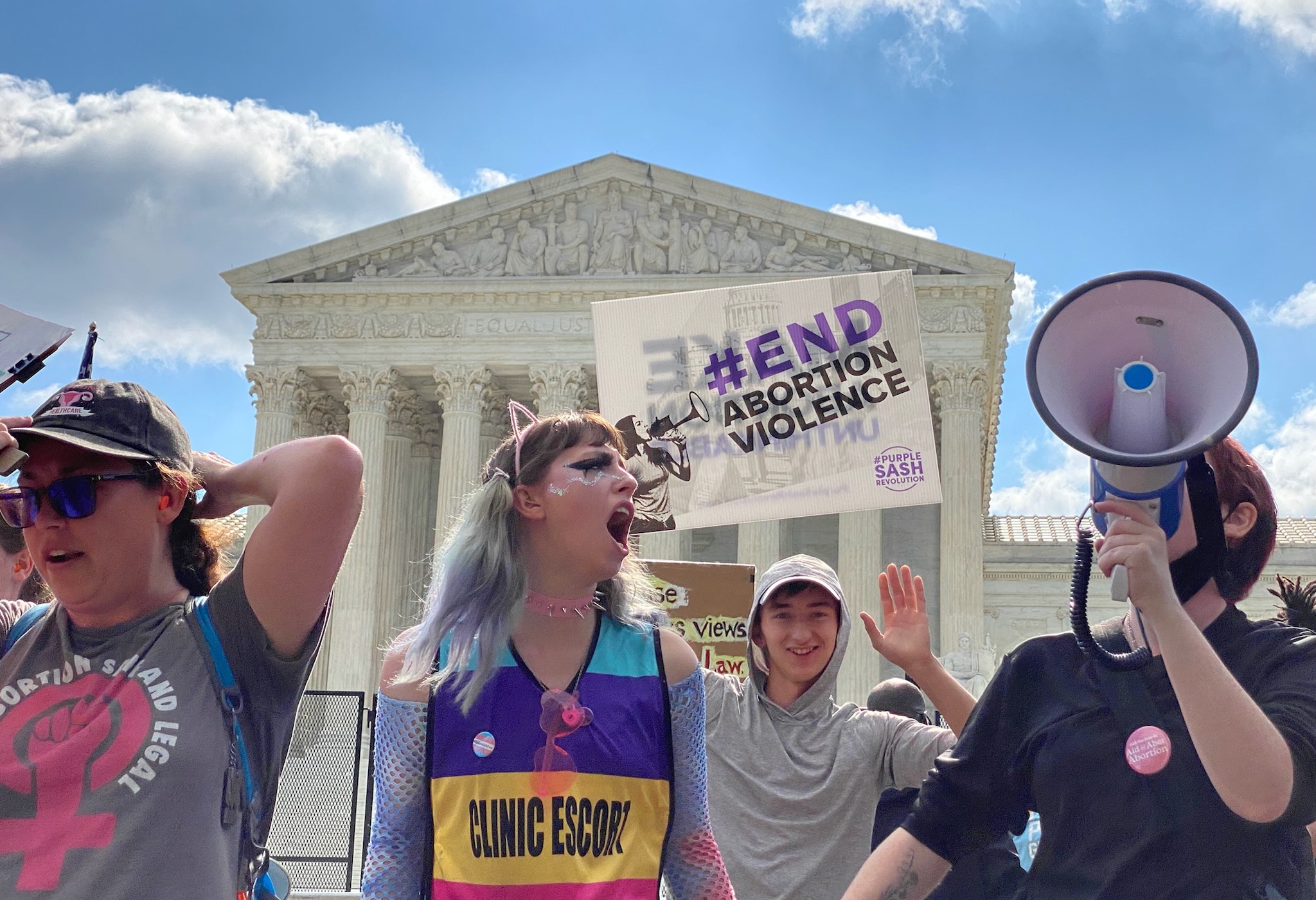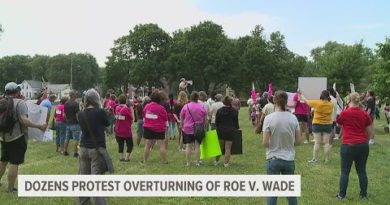Supreme Court overturns constitutional right to abortion
OPINION ANALYSIS
on Jun 24, 2022
at 10:13 am
Supporters and opponents of abortion rights protested in front of the Supreme Court on Friday. (Katie Barlow)
This article was updated on June 24 at 3:11 p.m.
The Supreme Court on Friday eliminated the constitutional right to obtain an abortion, casting aside 49 years of precedent that began with Roe v. Wade.
The decision by Justice Samuel Alito will set off a seismic shift in reproductive rights across the United States. It will allow states to ban abortion, and experts expect about half the states to do so.
In one of the most anticipated rulings in decades, the court overturned Roe, which first declared a constitutional right to abortion in 1973, and Planned Parenthood v. Casey, which re-affirmed that right in 1992. The decision followed the leak in early May of a draft opinion showing that a majority of the justices were privately poised to take that step. On Friday, they made it official.
The vote to overturn Roe was 5-4. Justices Clarence Thomas, Neil Gorsuch, Brett Kavanaugh, and Amy Coney Barrett joined Alito’s opinion. Chief Justice John Roberts did not join the opinion. He agreed with the majority that the Mississippi abortion restriction at issue in the case should be upheld, but in a separate opinion, he argued that the court should not have overturned Roe.
The court’s three liberals — Justices Stephen Breyer, Sonia Sotomayor, and Elena Kagan — filed a joint dissent. They called the majority opinion a violation of women’s autonomy and said it would harm the court’s legitimacy and jeopardize other constitutional rights.
The decision came in Dobbs v. Jackson Women’s Health Organization, a challenge to a 2018 Mississippi law that bans virtually all abortions after the 15th week of pregnancy. The law carves out exceptions for medical emergencies and cases involving a “severe fetal abnormality” but does not make exceptions for cases involving rape or incest. It never went into effect, however, because the lower courts – including the conservative U.S. Court of Appeals for the 5th Circuit – found the law clearly inconsistent with Roe and Caseyand blocked the state from enforcing it. Friday’s decision reversed the lower courts and upheld the law.
Its impact will spread far beyond Mississippi’s 15-week abortion law. By renouncing Roe and Casey (and decades of other abortion cases that relied on those decisions), the decision permits states to implement far more restrictive abortion laws. Mississippi itself has indicated that it will enforce a different state law, passed in 2007, that prohibits virtually all abortions, except to save the life of the mother or in cases involving rape. A dozen other states have passed similar legislation, known as “trigger laws” because they were drafted to go into effect if Roe and Casey were overturned. An analysis by the Guttmacher Institute predicts that 26 states are likely to ban all or nearly all abortions.
Alito’s majority opinion
Alito began his 79-page opinion by observing that abortion “presents a profound moral issue on which Americans hold sharply conflicting views.” But the Constitution does not refer to abortion at all, Alito stressed. And although the Supreme Court has recognized some constitutional rights as protected by the due process clause, even if they are not expressly mentioned in the Constitution, the right to an abortion is not one of them, Alito explained. Among other things, he noted, the court has required such rights to be “deeply rooted in our Nation’s history.” But until the second half of the 20th century, Alito observed, there was no support in U.S. law for the right to an abortion – indeed, he pointed out, most states regarded abortion as a crime.
Although the Supreme Court’s decisions in Roe and Casey established a right to an abortion, Alito continued, those decisions should be overruled despite the principle of stare decisis – the idea that courts should not overturn their prior precedent unless there is a compelling reason to do so. Stare decisis, Alito stressed, “is not a straitjacket” when a ruling is grievously incorrect. Noting that some of the Supreme Court’s other landmark decisions, such as Brown v. Board of Education, rejecting the “separate but equal” doctrine, had overruled precedent, Alito emphasized that Roe was “egregiously wrong and deeply damaging” and – along with Casey– should not be allowed to stand. Instead, Alito concluded, the issue of abortion should “return … to the people’s representatives.”
The majority contended that Friday’s ruling would not undermine other decisions by the court involving fundamental rights that the Constitution does not expressly mention, such as the right to contraception (Griswold v. Connecticut) and the rights to same-sex intimacy (Lawrence v. Texas) and marriage (Obergefell v. Hodges). Unlike those rights, Alito wrote, abortion terminates what Roe and Casey refer to as “potential life” and what the Mississippi law refers to as an “unborn human being.” “Nothing in this opinion,” Alito added later, “should be understood to cast doubt on precedents that do not concern abortion.”
Because abortion does not involve a fundamental right, Alito wrote, the Mississippi law is subject to the most lenient standard of review, known as rational-basis scrutiny. Laws can survive rational-basis review if there is a “rational basis on which the legislature could have thought that it would serve legitimate state interests.” Because the legislature enacted the Mississippi law to – among other things – “assert the State’s interest in ‘protecting the life of the unborn’” and because it regarded the procedure commonly used for abortions after the 15th week of pregnancy as “barbaric” and “demeaning to the medical profession,” Alito concluded, the abortion providers’ challenge to the law “must fail.”
A solo plea from Roberts
Calling the majority opinion “a serious jolt to the legal system,” Roberts agreed with the decision to uphold the Mississippi law, but he would have done so without formally overruling Roe and Casey. Echoing a position that he took at the oral argument (which then, as now, did not seem to attract any other supporters), Roberts would have allowed states to continue to regulate abortion without regard to whether the fetus has become viable – that is, the point at which it can survive outside the womb. In Casey, the court ruled that states may not ban abortions after the point of viability, which is typically considered to be at 22 to 24 weeks of pregnancy.
Roberts explained that the court’s prior cases had “adopted two distinct rules of constitutional law”: the right to end a pregnancy, and the states’ power to override that right at the point that the fetus becomes viable. Because the viability line “never made any sense,” Roberts wrote, he would “abandon that timing rule.” The right to terminate a pregnancy, Roberts reasoned, should “extend far enough to ensure a reasonable opportunity to choose, but need not extend any further.” The court could and should, Roberts wrote, “leave for another day whether to reject any right to an abortion at all.”
Concurrences from Kavanaugh and Thomas
Kavanaugh joined the Alito opinion but wrote a separate concurring opinion in which he emphasized that the Constitution is “neutral” on abortion and, therefore “this Court must also be scrupulously neutral” on the question. “The nine unelected Members of this Court do not possess the constitutional authority to override the democratic process and to decree either a pro-life or pro-choice abortion policy for all 330 million people in the United States.”
Kavanaugh also stressed the limits of Friday’s ruling. The court’s opinion, he wrote, “does not outlaw abortion throughout the United States” but instead “properly leaves the question of abortion for the people and their representatives.” It also, he said, “does not threaten or cast doubt” on decisions like Griswold or Obergefell. Moreover, he suggested, other questions that may flow from the court’s ruling – such as whether states can ban their residents from traveling to another state to obtain an abortion or whether a state can punish a resident who obtained an abortion before Friday’s ruling – “are not especially difficult as a constitutional matter.” The answer, Kavanaugh said, is “no.”
But a concurring opinion by Thomas indicated that, at least for him, decisions like Griswold, Lawrence, and Obergefell are very much in doubt. Thomas reiterated his view that the Constitution’s due process clause only protects process – the right to have the government follow proper procedures before taking away someone’s life, liberty, or property. The due process clause, Thomas wrote, does not protect any substantive rights. Because the Alito opinion concluded that there is no right to an abortion even under the Supreme Court’s substantive due process cases, Thomas explained, he joined the court’s opinion. But in a future case, he urged, the court should “reject substantive due process entirely” and reconsider cases like Griswold, Lawrence, and Obergefell.
The liberal justices dissent
In a rare joint dissent, Breyer, Sotomayor, and Kagan pushed back against the majority’s characterization of the decision as merely leaving the issue of abortion to the states. “We believe,” they wrote, “in a Constitution that puts some issues off limits to majority rule.”
The dissenters also rejected Kavanaugh’s depiction of Friday’s ruling as “neutral” on abortion. The court, they said, “does not act ‘neutrally’ when it leaves everything up to the States. Rather, the Court acts neutrally when it protects the right against all comers.” Kavanaugh’s position, they insisted, was instead a “brook-no-compromise refusal to recognize a woman’s right to choose.”
The dissenters warned that, despite assurances to the contrary, “no one should be confident that this majority is done with its work.” The right to an abortion at the core of Roe and Casey, the dissenters explained, is “part of the same constitutional fabric” as the rights to contraception and same-sex intimacy and marriage. “Either the mass of the majority’s opinion is hypocrisy,” the dissenters suggested, “or additional constitutional rights are under threat. It is one or the other.”
The three justices closed their 60-page dissent by arguing that Friday’s ruling had undermined the legitimacy of the court. The plurality in Casey – Justices Sandra Day O’Connor, Anthony Kennedy, and David Souter – believed that the public “should never conclude that its constitutional protections hung by a thread — that a new majority … could ‘by dint of numbers’ alone expunge their rights.” But by overruling Roe and Casey, the dissenters contended, the court had “betray[ed] its guiding principles.” Notably, the dissenters finished by noting only that they dissented, omitting the word “respectfully” that commonly accompanies the dissent.
This article was originally published at Howe on the Court.






